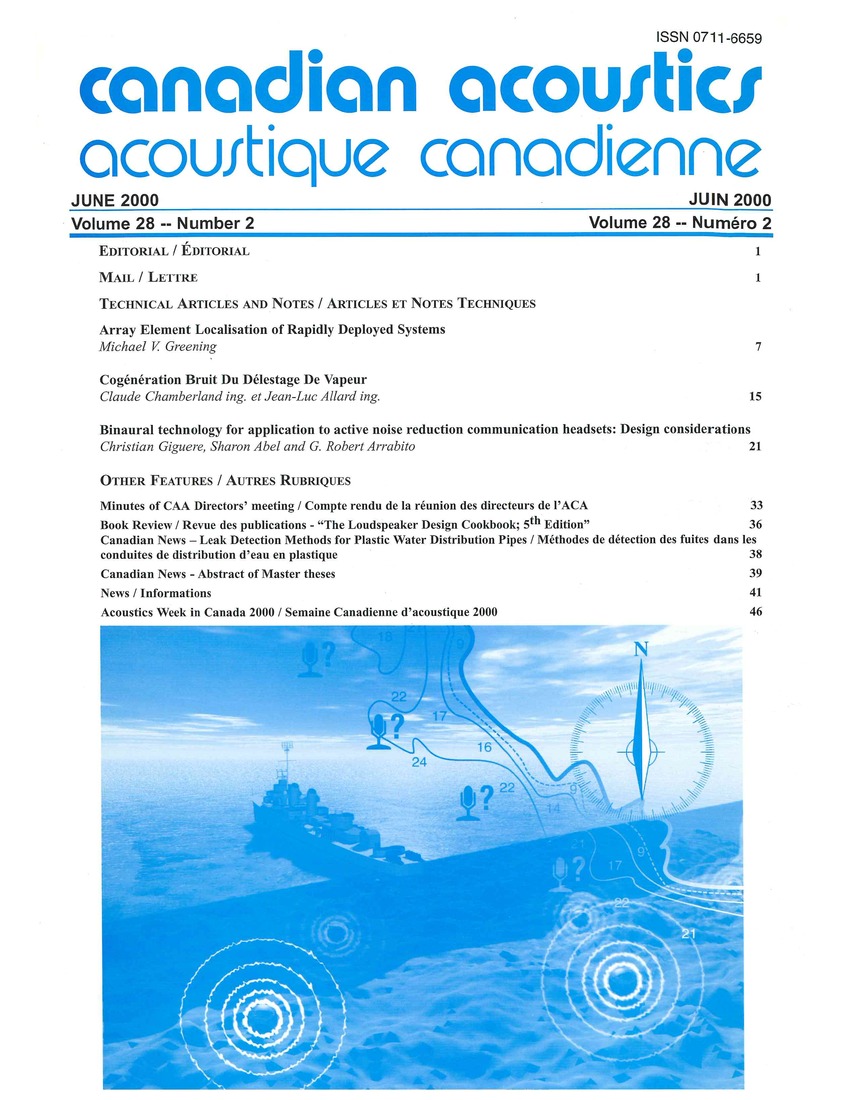Binaural technology for application to active noise reduction communication headsets: design considerations
Mots-clés :
Acoustic variables control, Cockpits (aircraft), Computer simulation, Design, Digital devices, Signal detection, Signal interference, Signal to noise ratio, Active noise reduction, Binaural technology, Communication headset, Three dimensional auditory displayRésumé
Cet article examine les principes de base et les aspects techniques nécessaires à l’intégration de deux technologies émergentes dans la conception de casques d’écoute pour les milieux bruyants. La première technologie, le contrôle actif du bruit, permet d’améliorer la détection de signaux et l’intelligibilité de la parole en réduisant l’interférence causée par le bruit environnant. La deuxième technologie, la technologie binau-rale, permet de créer un environnement d’écoute 3D, ce qui en retour permet d’améliorer la détection de signaux et l’intelligibilité de la parole dans le bruit, ainsi que la vigilance en situation d’écoute, par rapport à l’écoute monaurale. L’utilisation de casques actifs numériques est préférable aux casques actifs analogiques pour assurer une intégration optimale avec la technologie binaurale. La complexité du système total, tout particulièrement les caractéristiques de la simulation d’écoute binaurale, dépend en grande partie des exigences de l’application ciblée. Deux situations extrêmes appliquées à un environnement de cockpit d’avion sont analysées. L’avantage d’appliquer la technologie binaurale aux casques actifs sera le plus important en situation d’écoute où l’attention doit être partagée entre plusieurs signaux dans des milieux dont le rapport signal au bruit est faible.Fichiers supplémentaires
Publié-e
Comment citer
Numéro
Rubrique
Licence
Author Licensing Addendum
This Licensing Addendum ("Addendum") is entered into between the undersigned Author(s) and Canadian Acoustics journal published by the Canadian Acoustical Association (hereinafter referred to as the "Publisher"). The Author(s) and the Publisher agree as follows:
-
Retained Rights: The Author(s) retain(s) the following rights:
- The right to reproduce, distribute, and publicly display the Work on the Author's personal website or the website of the Author's institution.
- The right to use the Work in the Author's teaching activities and presentations.
- The right to include the Work in a compilation for the Author's personal use, not for sale.
-
Grant of License: The Author(s) grant(s) to the Publisher a worldwide exclusive license to publish, reproduce, distribute, and display the Work in Canadian Acoustics and any other formats and media deemed appropriate by the Publisher.
-
Attribution: The Publisher agrees to include proper attribution to the Author(s) in all publications and reproductions of the Work.
-
No Conflict: This Addendum is intended to be in harmony with, and not in conflict with, the terms and conditions of the original agreement entered into between the Author(s) and the Publisher.
-
Copyright Clause: Copyright on articles is held by the Author(s). The corresponding Author has the right to grant on behalf of all Authors and does grant on behalf of all Authors, a worldwide exclusive license to the Publisher and its licensees in perpetuity, in all forms, formats, and media (whether known now or created in the future), including but not limited to the rights to publish, reproduce, distribute, display, store, translate, create adaptations, reprints, include within collections, and create summaries, extracts, and/or abstracts of the Contribution.


